Showing 1–12 of 84 resultsSorted by latest
-
Sale!

Olive Mission 125lt
100-200lt Trees, All Plants, Full Sun Plants, Hedging Plants, Indigenous Plants, Olive Trees, Water Wise PlantsOriginal price was: R4,950.00.R2,795.00Current price is: R2,795.00.Add to cartOlive Mission 125lt
-
Sale!

Olive Frantoio 125lt
Original price was: R4,650.00.R2,795.00Current price is: R2,795.00.Add to cartOlive Frantoio 125lt
-
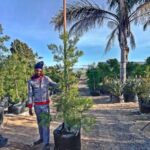
Afrocarpus Falcatus 125lt
R2,595.00Add to cartAfrocarpus Falcatus 125lt
Common Name: Outeniqua YellowwoodAfrocarpus falcatus is commonly known as the “Outeniqua Yellowwood.” It’s a large evergreen tree native to southern Africa.
The Outeniqua Yellowwood is a tall, stately tree that can reach heights of up to 40 meters.
It features dense, dark green foliage with needle-like leaves that are arranged in flattened sprays.Climate and Habitat
Native to the forests and mountainous regions of South Africa and Mozambique.
Thrives in temperate to subtropical climates.Sunlight
Prefers full sun to partial shade.
Can tolerate a range of light conditions but typically grows best in areas with good sunlight exposure.Soil
Thrives in well-draining, fertile soils.
Prefers slightly acidic to neutral soils.Watering
Requires regular watering, especially during dry periods and while establishing.
Once established, it can tolerate mild drought conditions.Temperature
Generally hardy in a range of temperatures, but protection from extreme cold may be necessary in colder regions.Pruning
Pruning is minimal and should be done to remove dead or diseased branches and maintain a healthy shape.Fertilisation
Fertilise in spring with a balanced, slow-release fertiliser to promote healthy growth.Pests and Diseases
Generally resistant to pests and diseases.
Proper care and spacing can help prevent issues.Landscaping Use
Often used as an ornamental and shade tree in larger gardens, parks, and estates. -
Sale!

Cupressus Sempervirens Stricta 125lt
Original price was: R4,150.00.R2,495.00Current price is: R2,495.00.Add to cartCupressus Sempervirens Stricta 125lt
Approx 2.5m Tall
-
Sale!
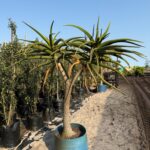
Aloe Barberae 125lt
Original price was: R4,150.00.R2,499.99Current price is: R2,499.99.Add to cartAloe Barberae 125lt
Common Name: Tree AloeAloidendron barberae
Previously known as Aloe Bainsii -
Sale!

Searsia Leptodictya 125lt
Original price was: R3,950.00.R1,999.99Current price is: R1,999.99.Add to cartSearsia Leptodictya 125lt
Common Name: Mountain KareeTrees are currently 2.7m Tall Approx.
Full Sun
Medium Watering
Drought Resistant
Indigenous
Evergreen -
Sale!

Liquidambar Styraciflua 125lt
Original price was: R3,950.00.R1,999.99Current price is: R1,999.99.Add to cartLiquidambar Styraciflua 125lt
Trees are currently 2.5m tall approx.
-
Sale!

Celtis Sinensis 125lt (Chinese Hackberry)
Original price was: R3,950.00.R1,499.99Current price is: R1,499.99.Add to cartCeltis Sinensis 125lt
Common Name: Chinese HackberryTrees are currently 3.0m Tall approx
Full Sun
Medium Watering
Drought Resistant
Exotic Tree
DeciduousCeltis sinensis is commonly known as Chinese Hackberry and is a species of flowering tree in the Cannabaceae family. It is native to various regions in East Asia, including China, Japan, Korea, and Taiwan. This deciduous tree is known for its adaptability and has been introduced and cultivated in other parts of the world as an ornamental tree.
Appearance: Chinese Hackberry is a medium-sized tree that can grow up to 10-20 meters in height. It has a rounded crown and a moderately spreading canopy. The bark is grey to light brown, and the branches are often covered with corky ridges.
Leaves: The leaves are alternate, simple, and have a serrated or toothed margin. They are typically ovate or elliptical and have a glossy green colour. In the fall, the leaves turn yellow or yellow-green before shedding.
Flowers: The tree produces small, inconspicuous greenish flowers in spring, usually in April or May, depending on the region. The flowers are not showy, but they are an essential food source for pollinators.
Fruits: After flowering, Celtis sinensis develops small, round, berry-like fruits that ripen to a dark purple or black colour. These fruits are often eaten by birds, contributing to seed dispersal.
Habitat: Chinese Hackberry is adaptable to various soil types and can tolerate a range of environmental conditions, including both moist and dry sites. It is commonly found in woodlands, forests, and along riverbanks.
Uses: Celtis sinensis is valued as an ornamental tree in landscapes and urban areas due to its attractive foliage, interesting bark texture, and adaptability to urban conditions. It can be planted as a shade tree, street tree, or in parks and gardens.
-
Sale!

Combretum Krausii Tree 125lt
Original price was: R3,950.00.R1,999.99Current price is: R1,999.99.Add to cartCombretum Krausii 125lt
Common Name: Forest BushwillowTrees are currently approx 3.0m Tall
Combretum krausii, commonly known as Forest Bushwillow, is a species of flowering tree belonging to the Combretaceae family. It is native to various regions in southern Africa, including countries such as South Africa, Zimbabwe, and Mozambique. Forest Bushwillow is a characteristic tree of wooded and forested areas in its native range.
Appearance: Forest Bushwillow is a medium to large-sized tree that can grow up to 10-20 meters in height, although it may reach greater heights under favourable conditions. It has a straight, cylindrical trunk and a spreading, rounded crown with dense foliage.
Leaves: The leaves are simple, opposite or subopposite, and usually measure around 5-10 cm in length. They are elliptical to lance-shaped and have a glossy green appearance. The leaves turn yellow or orange in the fall before shedding.
Flowers: The tree produces small, inconspicuous flowers that are greenish or cream-colored. The flowers are borne in dense, elongated spikes, which are attractive to various pollinators like bees and butterflies.
Fruits: After flowering, Forest Bushwillow develops fruits that are small, woody capsules containing seeds. The fruits are often eaten and dispersed by birds and other wildlife.
Habitat: As its name suggests, Forest Bushwillow is typically found in wooded areas, forests, and along riverbanks in its native range. It prefers well-drained soils and can tolerate a range of environmental conditions.
Uses: Combretum krausii has some uses in traditional medicine in certain regions. The tree’s bark and leaves are sometimes used for medicinal purposes by local communities. Additionally, the wood of Forest Bushwillow is used for various purposes, including making furniture and as firewood.
-
Sale!
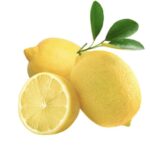
Eureka Lemon Tree 125lt Special
Original price was: R4,150.00.R2,950.00Current price is: R2,950.00.Add to cartEureka Lemon Tree 125lt Special
Approx 1.8m Tall
🍋 Eureka Lemon Tree
Botanical Name: Citrus limon ‘Eureka’
Type: Evergreen citrus fruit treeDescription
The Eureka Lemon is one of the most popular lemon varieties for home gardens and commercial growing. It produces bright yellow, medium- to large-sized lemons with a smooth rind, very few seeds, and a high juice content. It’s a prolific bearer and can produce fruit nearly all year round in mild climates.Key Features
Classic lemon flavour – tart, aromatic, and juicy
Virtually seedless fruit
Bears fruit year-round with peak in winter
Compact growth habit – ideal for pots or small gardens
Minimal thorns compared to other lemon typesGrowing Conditions
🌞 Sun: Full sun
🌱 Soil: Well-drained, fertile soil
💧 Watering: Moderate – allow top layer of soil to dry between waterings
❄️ Cold Tolerance: Sensitive to heavy frost – protect in winter
📏 Height: 3–4m tall (prune to shape)Uses
Perfect for fresh use, juicing, cooking, desserts, and preserving.Great For
Home gardens, patios, urban spaces, and indoor/outdoor container growing. -
Sale!
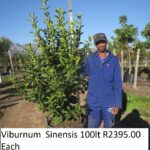
Viburnum Sinensis 100lt
100-200lt Trees, All Plants, All Plants On our Spring Sale, Full Sun Plants, Hedging Plants, Semi Shade PlantsOriginal price was: R3,450.00.R2,395.00Current price is: R2,395.00.Add to cartViburnum Sinensis 100lt
Common Name: Sweet ViburnumFull Sun
Semi Shade
Low Watering
Wind tolerant
Excellent Hedging plantFull Sun
Semi Shade
Low Watering
Wind tolerant
Excellent Hedging plantViburnum sinensis, commonly known as Sweet Viburnum, is a deciduous shrub found in South Africa. It belongs to the Adoxaceae family and is a favoured ornamental plant due to its beautiful flowers and attractive foliage.
Sweet Viburnum is renowned for its large, striking flower clusters that resemble fluffy, round snowballs, earning it its common name. These flower clusters can reach sizes of 15 to 20cm in diameter and are typically creamy white in colour. They grace the garden with their presence in late spring to early summer, creating a stunning visual display.
The leaves of Viburnum sinensis are oval-shaped, glossy, and dark green. During autumn, they often transition to hues of red or purple, adding to the shrub’s visual appeal. This particular shrub can grow to heights of 6 meters and has a rounded or slightly spreading growth habit.
Viburnum Sinensis thrives in areas with full sun to partial shade in South Africa. It prefers well-draining soil and exhibits tolerance to various soil types, including clay, loam, or sandy soil. Regular watering is necessary during the establishment phase, but once established, it can withstand some drought conditions.
Pruning is typically carried out after the flowering period to maintain the desired shape and remove any dead or damaged branches. This practice can also encourage better flower production for the following year.
Viburnum sinensis is generally a hardy and low-maintenance shrub in South Africa. It exhibits relative resistance to pests and diseases. However, it is recommended to monitor the plant for any signs of issues and take appropriate action if necessary.
Sweet Viburnum is often utilised as a focal point in landscaping, as a hedge, or as part of mixed shrub borders in South Africa. Its large, eye-catching flowers make it a standout in the garden and attract bees and butterflies. Additionally, the flowers can be cut and used in floral arrangements to bring their beauty indoors.
Overall, Viburnum sinensis, is a delightful shrub appreciated for its stunning flower clusters and attractive foliage in South African gardens. Its resilience, low maintenance requirements, and versatility in various garden settings make it a popular choice for adding beauty and charm to outdoor spaces.
-
Sale!
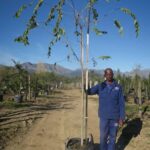
White Stinkwood Tree 100lt
Original price was: R3,950.00.R2,250.00Current price is: R2,250.00.Add to cartCeltis Africana 100lt (White Stinkwood)
Common Names: White Stinkwood, witstinkhouFull Sun
Medium Watering
IndigenousFast-growing shade tree that grows up to 10m in height with a wide crown and characteristic smooth, grey trunk.
They have an invasive root system and are not suitable for small gardens.Celtis Africana is commonly known as White Stinkwood and is a species of deciduous tree belonging to the Cannabaceae family. It is native to various regions in Africa, including South Africa, Zimbabwe, Mozambique, and Swaziland.
Appearance: The White Stinkwood is a medium to large-sized tree that can grow up to 20-25 meters in height. It has a spreading canopy with a rounded or irregular shape. The bark is smooth and greyish-white when young, but it becomes rough and darkens with age.
Leaves: The leaves are simple, alternate, and have a serrated margin. They are elliptical in shape and can be 4-10 cm long. The leaves are typically bright green, turning yellow to golden in autumn before falling off in winter.
Flowers: The tree produces inconspicuous, small, greenish flowers in late spring or early summer. These flowers are not showy but are important as a nectar source for insects.
Fruits: After flowering, Celtis africana develops small, fleshy, and roundish fruits that turn from green to orange or purplish when ripe. The fruits are edible and are consumed by various birds and mammals, contributing to seed dispersal.
Habitat: The White Stinkwood is commonly found in a variety of habitats, including forests, woodlands, and along riverbanks. It is a hardy and adaptable species that can tolerate a range of conditions.
Uses: In some regions, the wood of Celtis africana has been used for various purposes, including furniture, carvings, and construction. However, it is not as extensively used as some other tree species due to its relative softness. The tree is also valued for its role in providing shade, food for wildlife, and ornamental qualities.
It’s worth noting that the common name “White Stinkwood” comes from the strong, unpleasant smell emitted by the wood when freshly cut. This odour tends to dissipate as the wood dries, and it does not pose any health risks.
